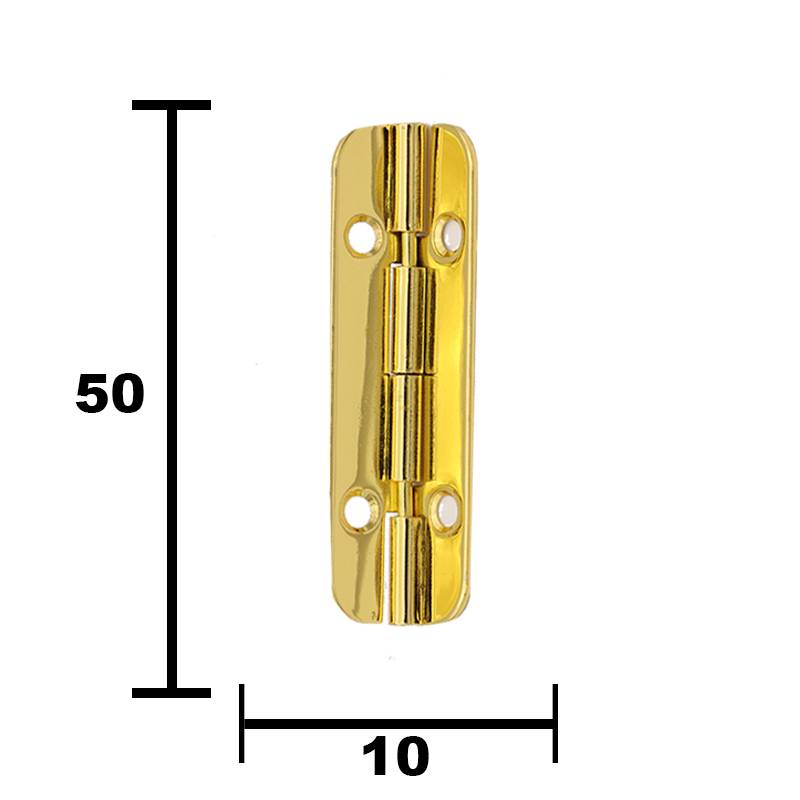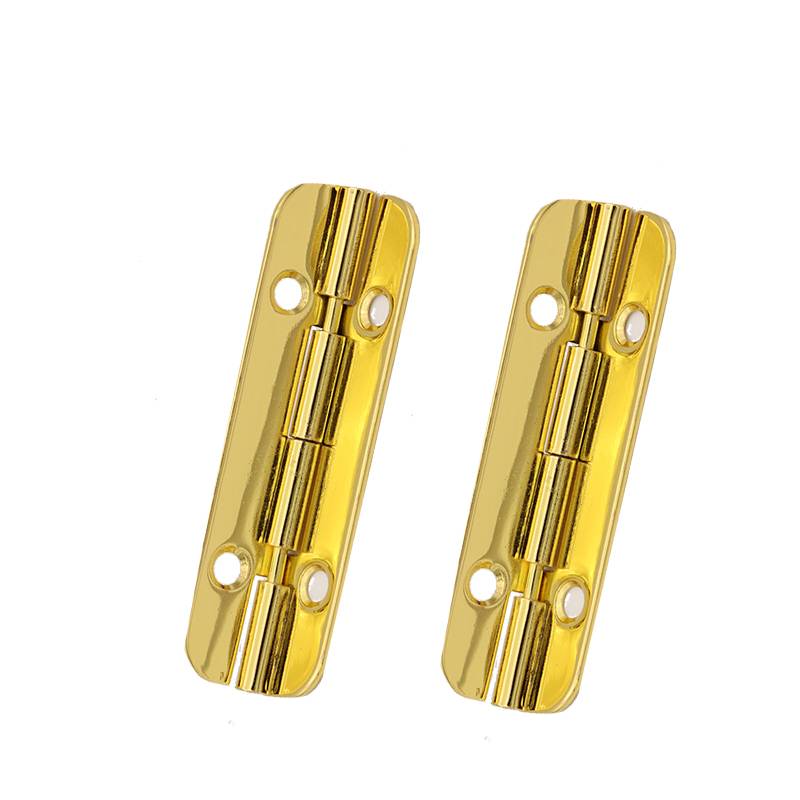Mini Butt Hinge for Wooden Boxes – Ultimate Guide and Buying Tips
What is a Mini Butt Hinge?
A mini butt hinge is a small-sized hinge designed primarily for use in compact and delicate applications such as jewelry boxes, wooden cases, craft projects, model making, mini cabinets, and other small woodworking items. While sharing the same basic structure as standard butt hinges, mini butt hinges are specifically manufactured in tiny dimensions, making them suitable for projects where space and weight are limited but smooth movement and durability remain essential.
Butt hinges are known for their two matching plates (leaves) attached by a central pin. These plates are mounted on adjoining surfaces and allow the two parts (typically a box lid and its base) to pivot smoothly for repeated opening and closing. In the case of mini butt hinges, the reduced size makes them less obtrusive and more aesthetically suitable for fine woodworking and box making.
Key Features of Mini Butt Hinges
-
Compact Size: Designed for applications requiring small components.
-
Durable Construction: Usually made from brass, stainless steel, or iron, ensuring long lifespan.
-
Smooth Operation: Engineered for frictionless and noise-free movement.
-
Easy Installation: Pre-drilled holes for quick and simple screw fitting.
-
Variety of Finishes: Available in polished brass, antique, nickel plating, or black oxide coatings to suit various aesthetic needs.
-
Lightweight: Perfect for boxes or miniature furniture that cannot support heavy hardware.
-
Versatility: Suitable for jewelry boxes, keepsake containers, display cases, model buildings, and more.
Common Applications of Mini Butt Hinges
-
Jewelry Boxes:
Provide a secure and smooth lid movement, adding an elegant touch to handcrafted jewelry storage.
-
Keepsake and Gift Boxes:
Ideal for small wooden or decorative boxes, ensuring years of reliable use.
-
DIY Craft Projects:
Hobbyists and model builders rely on mini butt hinges for dollhouses or detailed craft work.
-
Cigar and Wine Boxes:
Maintain the integrity of special or vintage containers while ensuring accessibility.
-
Display Cases:
Used in mini display furniture or glass boxes to secure hinged sections.
-
Restoration Work:
Essential in repairing or upgrading vintage and antique small wooden boxes.
Materials and Finishes
Selecting the right material and finish is crucial to ensuring both appearance and longevity:
-
Brass:
Popular for its corrosion resistance and classic gold-toned finish. Ideal for decorative boxes.
-
Stainless Steel:
Highly resistant to rust and tarnish, suitable for boxes exposed to moisture or requiring extra strength.
-
Iron:
Often chosen for vintage or rustic aesthetics. Must be properly coated to prevent rust.
-
Surface Treatments:
Offers additional protection and complements wood finishes. Common options include antique brass, polished nickel, and matte black.
How to Choose the Right Mini Butt Hinge
1. Measure Your Box
-
Determine lid and base thickness.
-
Size the hinge so it fits comfortably without sticking out.
2. Select the Material
-
For humid or high-contact environments, opt for stainless steel.
-
For vintage style or fine woodworking, consider polished or antique brass.
3. Decide on Surface Finish
-
Match the hardware finish to complement wood tone and overall box design.
4. Check the Number of Screw Holes
-
Heavier lids or larger boxes may need 4-screw hinges for better support.
5. Choose Pin Type
-
Fixed pins are secure; removable pins may be useful for easy disassembly during maintenance.
6. Count Needed Hinges
-
Most small boxes require 2 mini butt hinges for stability.
Installation Guide for Mini Butt Hinges
Tools Required:
Mini Phillips or flathead screwdriver, ruler, small drill (optional), pencil.
Installation Steps:
-
Mark the Placement:
Place the hinge on the lid edge, mark screw holes with a pencil.
-
Pre-Drill Holes:
For hardwood, gently drill pilot holes to prevent wood splitting.
-
Position the Hinge:
Align hinge properly; ensure both leaves are flush with the wood surface.
-
Attach with Screws:
Use provided or compatible small screws, tighten gently.
-
Repeat on Second Hinge:
Ensures even lid support and smooth movement.
-
Test Movement:
Open and close the box to confirm seamless operation; adjust if necessary.
Maintenance and Care Tips
-
Keep Hinges Clean:
Wipe with a dry cloth; use a damp cloth for stubborn dirt but avoid excess water.
-
Prevent Rust:
For brass or iron, apply a tiny amount of wax or oil periodically.
-
Check Screws Regularly:
Tighten if you notice any play or looseness.
-
Lubrication:
If hinges squeak, a drop of sewing machine oil or graphite can restore quiet movement.
-
Avoid Overloading:
Do not force the lid or exceed hinge weight capacity.
Advantages of Using Mini Butt Hinges for Wooden Boxes
-
Professional Appearance:
Discreet and elegant, enhancing the handmade look of any box.
-
Durability:
High-quality hinges ensure the box can be opened and closed thousands of times.
-
Customization:
Wide variety of sizes and finishes to suit unique craft projects.
-
Affordable:
Budget-friendly solution without compromising on quality.
Buying Tips and Recommendations
-
Order from Trusted Suppliers:
Choose brands with consistent quality and good customer feedback.
-
Bulk Purchase Options:
Save money by purchasing mini butt hinges in multi-pack sets, ideal for craft businesses.
-
Request Samples:
For large projects or gifts, request samples or test a few hinges before bulk orders.
-
Check for Warranty:
Some high-end brands offer guarantees on finish and durability.
-
Review Installation Guides:
Choose suppliers who provide clear instructions or support.
Mini Butt Hinge for DIY and Handcrafted Projects
Why do crafters and woodworkers choose mini butt hinges?
Because mini butt hinges combine strength, versatility, and low-profile design, making them the preferred choice for hand-crafted wooden boxes, personalized gifts, and custom cabinetry. Whether restoring a vintage jewelry box or building a new keepsake case, these small but essential hardware items ensure reliable lid movement and a polished finish.
Conclusion
The mini butt hinge is a small, affordable, and essential piece of hardware for anyone creating or restoring wooden boxes and mini furniture. Its compact size, reliable performance, and numerous finish options make it an ideal choice for craftspeople, hobbyists, and professional woodworkers worldwide. When installed correctly and maintained well, a quality mini butt hinge ensures your handmade boxes retain their elegance and functionality for years to come.
If you are seeking the perfect hardware for jewelry boxes, keepsake containers, or model cabinets, look no further than the mini butt hinge—a must-have for every woodworker and DIY enthusiast.
Looking for more information or specific advice about mini butt hinges? Contact our product specialists or browse our help center for detailed guides and installation videos!



Frequently Asked Questions (FAQ) About Mini Butt Hinges
Q1: What size mini butt hinge should I use for a small jewelry box?
A: For most jewelry boxes, hinges between 10×8 mm and 16×10 mm are ideal. The choice depends on box dimensions and lid weight.
Q2: Are screws included with mini butt hinges?
A: Many suppliers include matching screws, but always check product details. Small brass or steel screws typically work best.
Q3: Can I use mini butt hinges outdoors?
A: Brass or stainless steel mini butt hinges are resistant to corrosion and suitable for damp environments, but avoid prolonged direct exposure to rain.
Q4: How can I avoid splitting wood during installation?
A: Pre-drill small pilot holes slightly smaller than screw diameter, especially in hardwoods.
Q5: Can mini butt hinges be installed on acrylic or plastic boxes?
A: Yes, but use self-tapping screws designed for plastic. Align gently to avoid cracking.










